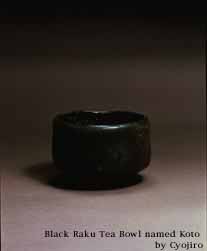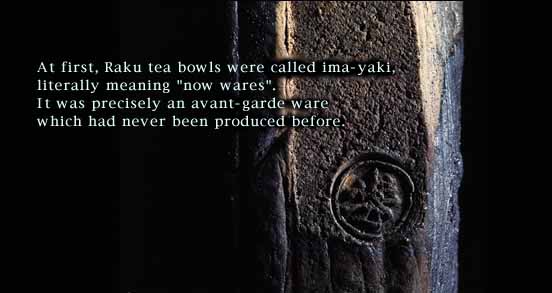 The characteristics of Raku tea bowls as
pioneered by Ch˘jir˘ are their exclusive use of monochrome black or red
glazes - in marked contrast to the brightness of the san cai wares from
which they evolved - and an unique aesthetic which aims at the elimination
of movement, decoration and variation of form. In this Raku wares reflect
more directly than any other kind of ceramic the ideals of wabicha, the
form of tea ceremony based on the aesthetics of wabi advocated by Sen
Rikyu. Central to the philosophy of wabicha were notions of "nothingness"
deriving from Zen Buddhism and the "isness" of Taoism. Raku wares are
hand-formed rather than thrown on the wheel, which makes them very
different from other kinds of Japanese ceramics. Hand-forming increase the
potential for modelling and allows the spirit of the artist to speak
through the finished work with particular directness and intimacy.
Ch˘jir˘, however, through his negation of movement, decoration and
variation of form, went beyond the boundaries of individualistic
expression and elevated the tea bowl into a manifestation of abstract
spirituality. The characteristics of Raku tea bowls as
pioneered by Ch˘jir˘ are their exclusive use of monochrome black or red
glazes - in marked contrast to the brightness of the san cai wares from
which they evolved - and an unique aesthetic which aims at the elimination
of movement, decoration and variation of form. In this Raku wares reflect
more directly than any other kind of ceramic the ideals of wabicha, the
form of tea ceremony based on the aesthetics of wabi advocated by Sen
Rikyu. Central to the philosophy of wabicha were notions of "nothingness"
deriving from Zen Buddhism and the "isness" of Taoism. Raku wares are
hand-formed rather than thrown on the wheel, which makes them very
different from other kinds of Japanese ceramics. Hand-forming increase the
potential for modelling and allows the spirit of the artist to speak
through the finished work with particular directness and intimacy.
Ch˘jir˘, however, through his negation of movement, decoration and
variation of form, went beyond the boundaries of individualistic
expression and elevated the tea bowl into a manifestation of abstract
spirituality.
Ch˘jir˘'s elimination of movement, decoration and
variation of form and his delving beyond the boundaries of individualistic
expression manifested themselves in works of monochromatic silence. To
deliberately negate attempt at any formative expression is, as if
creativity tries to go beyond the act of creation itself, a paradoxical
and extraordinary spiritual endeavour. What was Ch˘jir˘ trying to achieve?
What are we to understand from his attainments? 400 years later, the
issues of spirituality and artistic consciousness addressed by Ch˘jir˘ are
as valid and relevant as ever. |


 The characteristics of Raku tea bowls as
pioneered by Ch˘jir˘ are their exclusive use of monochrome black or red
glazes - in marked contrast to the brightness of the san cai wares from
which they evolved - and an unique aesthetic which aims at the elimination
of movement, decoration and variation of form. In this Raku wares reflect
more directly than any other kind of ceramic the ideals of wabicha, the
form of tea ceremony based on the aesthetics of wabi advocated by Sen
Rikyu. Central to the philosophy of wabicha were notions of "nothingness"
deriving from Zen Buddhism and the "isness" of Taoism. Raku wares are
hand-formed rather than thrown on the wheel, which makes them very
different from other kinds of Japanese ceramics. Hand-forming increase the
potential for modelling and allows the spirit of the artist to speak
through the finished work with particular directness and intimacy.
Ch˘jir˘, however, through his negation of movement, decoration and
variation of form, went beyond the boundaries of individualistic
expression and elevated the tea bowl into a manifestation of abstract
spirituality.
The characteristics of Raku tea bowls as
pioneered by Ch˘jir˘ are their exclusive use of monochrome black or red
glazes - in marked contrast to the brightness of the san cai wares from
which they evolved - and an unique aesthetic which aims at the elimination
of movement, decoration and variation of form. In this Raku wares reflect
more directly than any other kind of ceramic the ideals of wabicha, the
form of tea ceremony based on the aesthetics of wabi advocated by Sen
Rikyu. Central to the philosophy of wabicha were notions of "nothingness"
deriving from Zen Buddhism and the "isness" of Taoism. Raku wares are
hand-formed rather than thrown on the wheel, which makes them very
different from other kinds of Japanese ceramics. Hand-forming increase the
potential for modelling and allows the spirit of the artist to speak
through the finished work with particular directness and intimacy.
Ch˘jir˘, however, through his negation of movement, decoration and
variation of form, went beyond the boundaries of individualistic
expression and elevated the tea bowl into a manifestation of abstract
spirituality.